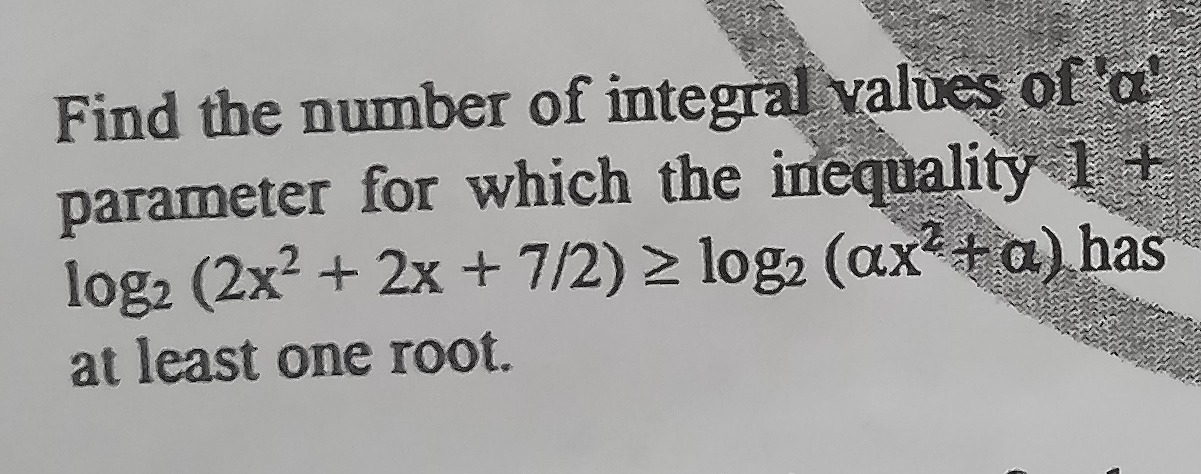Question
Question: Find the number of integral values of 'a' parameter for which the inequality $1 + \log_2(2x^2 + 2x +...
Find the number of integral values of 'a' parameter for which the inequality 1+log2(2x2+2x+7/2)≥log2(αx2+α) has at least one root.

6
Solution
The given inequality is 1+log2(2x2+2x+7/2)≥log2(αx2+α).
Step 1: Determine the domain of the logarithmic expressions.
For log2(2x2+2x+7/2) to be defined, 2x2+2x+7/2>0. The discriminant of the quadratic 2x2+2x+7/2 is Δ=(2)2−4(2)(7/2)=4−28=−24. Since the discriminant is negative (Δ<0) and the leading coefficient is positive (2>0), the quadratic 2x2+2x+7/2 is always positive for all real values of x.
For log2(αx2+α) to be defined, αx2+α>0. This can be factored as α(x2+1)>0. Since x2+1 is always positive (in fact, x2+1≥1 for all real x), for the product α(x2+1) to be positive, we must have α>0. This is a crucial condition for α.
Step 2: Simplify the inequality.
The inequality can be rewritten using logarithm properties: 1+log2(2x2+2x+7/2)≥log2(αx2+α) log2(2)+log2(2x2+2x+7/2)≥log2(α(x2+1)) log2(2(2x2+2x+7/2))≥log2(α(x2+1)) log2(4x2+4x+7)≥log2(αx2+α)
Since the base of the logarithm is 2, which is greater than 1, the log2(t) function is increasing. Therefore, we can remove the logarithm: 4x2+4x+7≥αx2+α Rearrange the terms to form a quadratic inequality: (4−α)x2+4x+(7−α)≥0
Let f(x)=(4−α)x2+4x+(7−α). We need to find the integral values of α (with α>0) for which f(x)≥0 has at least one real root.
Step 3: Analyze the quadratic inequality based on the coefficient of x2.
Case 1: The coefficient of x2 is zero. 4−α=0⟹α=4. If α=4, the inequality becomes: 0⋅x2+4x+(7−4)≥0 4x+3≥0 x≥−3/4. This linear inequality has infinitely many solutions for x. Since α=4 satisfies the condition α>0, α=4 is a valid integral value.
Case 2: The coefficient of x2 is non-zero. 4−α=0. For a quadratic Ax2+Bx+C≥0 to have at least one solution, we consider two sub-cases based on the sign of A and the discriminant Δ=B2−4AC.
Subcase 2a: The parabola opens upwards. 4−α>0⟹α<4. For f(x)≥0 to have at least one root, the parabola must either touch or intersect the x-axis. This means the discriminant of f(x) must be non-negative (Δ≥0). Δ=(4)2−4(4−α)(7−α)≥0 16−4(28−4α−7α+α2)≥0 Divide by 4: 4−(α2−11α+28)≥0 4−α2+11α−28≥0 −α2+11α−24≥0 Multiply by -1 and reverse the inequality sign: α2−11α+24≤0 Factor the quadratic: (α−3)(α−8)≤0 This inequality holds when 3≤α≤8.
Now, combine this with the conditions for this subcase: α>0 (from domain) and α<4. The intersection of 3≤α≤8, α<4, and α>0 is 3≤α<4. The only integral value of α in this range is α=3.
Subcase 2b: The parabola opens downwards. 4−α<0⟹α>4. For f(x)≥0 to have at least one root, the parabola must intersect or touch the x-axis (since it opens downwards, it will be positive between the roots if they exist). This again requires the discriminant to be non-negative (Δ≥0). The discriminant calculation is the same as in Subcase 2a: Δ=(4)2−4(4−α)(7−α)≥0⟹3≤α≤8.
Now, combine this with the conditions for this subcase: α>0 (from domain) and α>4. The intersection of 3≤α≤8, α>4, and α>0 is 4<α≤8. The integral values of α in this range are α=5,6,7,8.
Step 4: Collect all valid integral values of α. From Case 1: α=4. From Subcase 2a: α=3. From Subcase 2b: α∈{5,6,7,8}.
Combining all these values, the set of integral values of α for which the inequality has at least one root is {3,4,5,6,7,8}. The number of integral values is 6.
The final answer is 6.
